Wstęp: Łamanie pieczęci. List jako szczególny gatunek literacki (Barbara Wolska)
List to szczególny gatunek literatury okolicznościowej i użytkowej, cechujący się ogromną różnorodnością. Trzeba pamiętać, że poza listem autentycznym jako dokumentem biograficznym spotykamy też listy fikcyjne, paraliterackie i literackie. W formie listu wydawano bardzo różne utwory i na pewno w jego obrębie obserwujemy osobiste zaangażowanie, niekoniecznie rozumiane tylko jako obecność elementów biograficznych.
Warto przypomnieć listy o charakterze wypowiedzi estetycznej, normatywnej, poczynając od Listu do Pizonów (Sztuki poetyckiej) Horacego, skierowany do ówczesnych wydawców; Listy o smaku, czyli o guście Józefa Szymanowskiego (poetyka rokoka). Spotykamy też w dziejach piśmiennictwa wypowiedzi refleksyjno-filozoficzne w formie listu: O szczęściu człowieka. List do Rozyny Franciszka Karpińskiego; a także list jako formę podawczą utworu powieściowego lub jego fragmentów, np.: Nowa Heloiza J.J. Rousseau, Niebezpieczne związki Choderlosa de Laclos, częściowo Malwina Marii z Czartoryskich Wirtemberskiej.
Pamiętajmy jednak, że dawniej list pisarza nierzadko był kierowany do szerszego grona odbiorców, pozornie tylko do jednego adresata, a w istocie bywał odczytywany głośno wśród znajomych i przyjaciół. A więc list autentyczny mógł już w zamierzeniu zawierać element kreacyjności, mógł być nie tylko dokumentem osobistym, zwierzeniem się ze swoich problemów, trosk, pragnień, planów, lecz i utworem literackim w zamierzeniu nadawcy.
Niezależnie od tego list cenimy jako dokument biograficzny i historyczny zarazem, ze świadomością, że może, choć nie musi, posiadać on znaczne walory literackie. Wartość artystyczna listu zależała od nadawcy, w mniejszym nawet stopniu od jego stanowiska w hierarchii społecznej i od treści przekazywanych przez niego wybranym osobom, w tym informacji niekiedy tajemnych, nieznanych ogółowi, w większym stopniu zaś – od jego inwencji i sprawności pióra.
Ponieważ w części edytorskiej planowanego monograficznego numeru XXIII rocznika „Napis” będą edytowane listy osobne, kierowane do jednego adresata, ale także fragmenty korespondencji danego (interesującego z różnych względów) nadawcy do wielu adresatów, to należy przypomnieć Autorom pewne zagadnienia. ważne dla edytorstwa wypowiedzi listownych. Pierwszym istotnym, nierozstrzygniętym do dziś jednoznacznie pytaniem jest kwestia granic poszanowania intymności, prawa do wydawania (a zatem upublicznienia) listów bardziej lub mniej znanego nadawcy, zawierających treści intymne, odsłaniające niepochlebne rysy psychiki i drastyczne zdarzenia z życia, zwłaszcza gdy może to skrzywdzić osoby jeszcze żyjące lub zniszczyć utrwalony w powszechnej pamięci wizerunek nadawcy? Decyzja o edycji korespondencji, odsłaniającej nie tylko relacje osobiste między nadawcą a adresatem / adresatami, lecz nieznane, niekiedy nawet szokujące kulisy interesujących zdarzeń, może być tyleż ważna, co kontrowersyjna.
Wydanie krytyczne listu jest zadaniem szczególnie odpowiedzialnym, nie tylko ze względu na możliwość zaginięcia autografu, ale i konieczność odpowiedniego opracowania edytorskiego: oprócz zgodnych ze współczesnym stanem badań wiadomości o adresacie i nadawcy, do edycji powinny być załączone objaśnienia merytoryczne i językowe oraz zasady transkrypcji i informacje o źródle. Objaśnienia w wydaniu korespondencji to sprawa niesłychanie ważna. To edytor jest przewodnikiem po tajemniczym świecie listu, on musi go nierzadko najpierw odcyfrować (co przy nieczytelnym piśmie wiąże się z problemem wprowadzania emendacji i koniektur), częstokroć również on na podstawie rozmaitych przesłanek ustala datację dokumentu, a wreszcie do jego zadań należy również wyświetlenie wielu epistolograficznych zagadek. Są bowiem w listach poruszane niekiedy sprawy niejasne, trudne, co zmusza do poszukiwań, do rozjaśnienia zawikłanych spraw, zwłaszcza jeśli w edycji dominuje cel dydaktyczno-naukowy.
Zagadnienia interesujące nas w rekomendowanej tu serii czasopisma „Napis”:
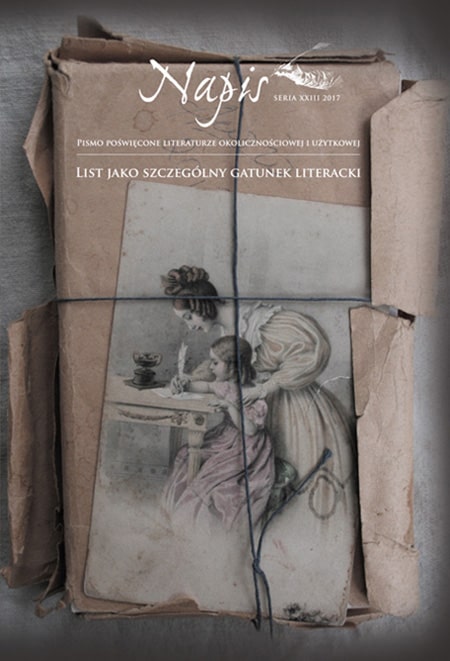
Wstęp: Łamanie pieczęci. List jako szczególny gatunek literacki (Barbara Wolska)
Mariola JARCZYKOWA
Familijne „pisania” żon i córek Radziwiłłów z XVII wieku
Artykuł (PDF) Show abstract Hide abstract
The article presents the correspondence of the members of the Radziwiłł family from the Birżai line, based mainly on the manuscripts from the National Library in Warsaw (ref. no. III 3277). The letters of Krzysztof Radziwiłł’s (1585-1640) closest relatives: his sister Elżbieta, his wife Anna, his daughter Katarzyna and his granddaughter Anna Maria contain some typical elements – questions about health, expressions of godliness and longing, and feelings towards the addressees. The analysed epistolary texts are mostly edited in a conventional way, although Anna Maria uses quotes, jokes, biblical allusions. Hand-written letters express mainly emotions, containing little information about public matters. They focus above all on the private life.
Iwona MACIEJEWSKA
Intrygujący trójgłos – małżeństwo Magdaleny i Hieronima Floriana Radziwiłłów w świetle listów Konstancji z Gnińskich Czapskiej
Artykuł (PDF) Show abstract Hide abstract
The article describes the collection of letters of Pomeranian voivode’s wife Konstacja Czapska addressed to her daughter Magdalena and her son-in-law, duke Hieronim Florian Radziwiłł. The letters from the collection of the Central Archives of Historical Records in Warsaw appeared to be a very important and useful source to research the history of this stormy marriage, which was taken probably in 1745 and ended after several years by its annulment. The emotional relation between Magdalena and Hieronim Radziwiłł was shown in recently published letters of Magdalena addressed first to her fiancé and later husband (introduction and ed. I. Maciejewska, K. Zawilska, Olsztyn 2016). Letters written by Konstancja Czapska are a priceless voice in understanding the marriage, yet they were not given much space in the aforementioned edition for obvious reasons. Nonetheless, it is a very interesting collection, showing the author’s correspondence talent and intelligence and also the ability to diversify her statements depending on the aim and addressee. It is an interesting evidence of the relationship between a mother and a daughter, which is important not only at the moment of arranging the marriage taken in unusual circumstances, but also when it becomes a source of support during the crisis in the marriage.
Monika URBAŃSKA
Listy prozatorskie w „Zabawach Przyjemnych i Pożytecznych” – autorzy, tematy, funkcje
Artykuł (PDF) Show abstract Hide abstract
In this article, I have focused on eight prose letters in “Zabawy Przyjemne i Pożyteczne”. The first two are by Franciszek Bieńkowski and concern the issue of good education – good treatment for people with lower social status.
The next four letters are the correspondence of three great figures of the Renaissance: the Polish king Stefan Batory, his secretary and statesman Jan Zamoyski and the distinguished Italian humanist Antoni Muret. These letters, coming from the 16th century and written in Latin, were translated by Józef Koblański in the 70s of the 18th century. The texts are examples of traditional epistolary art based on ancient principles.
The seventh letter of unknown authorship compliments the reforms of the National Education Commission and polemizes with its opponents. The deliberate form of the letter used to promote a state educational institution and to argue with the critics of its reforms suggests that it is a letter falsified for the promotion of the social good of universal and unified education. The name of the addressee of the letter has not been specified what makes the correspondence general and illustrative in character.
The last letter is basically a preface to the Polish edition of a well-known book of French doctor – Samuel Tissot. The book is entitled The Council for the People and concerns the principles of healthy living. The author of the letter – Grzegorz Piramowicz – enumerates the advantages of the book and the merits of her author and praises those who translated the book into Polish.
The prose letters discussed in this article which were published in “Zabawy Przyjemne i Pożyteczne” present a large variety of themes and topics brought up in the periodical starting from current issues to the examples of early Enlightenment literature and culture.
Tadeusz PÓŁCHŁOPEK
Epistolarny portret cesarskiego szambelana – mecenasa polskiej kultury. Korespondencja Stanisława Dunina Borkowskiego do autora „Parafiańszczyzny”
Artykuł (PDF) Show abstract Hide abstract
Around one hundred letters written by Stanisław Dunin Borkowski between 1833-1840 addressed from Vienna to Winniczki near Lviv, maintained in the collection of the Ossolineum in Wrocław, present a portrait of a nobleman – a dilettante with a wide spectrum of interests in culture, spending enormous amounts of money in order to ensure himself a proper position at the Austrian court.
It is the emperor’s chamberlain connections with the “enlightened” Europe that made him abolish serfdom in his estate in 1818. As he himself spent most of his time in Vienna, in 1833 he commissioned the management of his estate to his nephew Aleksander (Leszek Dunin Borkowski) – the future author of the renown Parafiańszczyzna.
Most of the letters consist of excuses such as: “Maybe there will be a need to head to the baths or maybe stay here for one more month. […] Maybe I will greet you in about a month or maybe in three months. Nevertheless, dear Oleś, do not wait for me, just run the household as if it was your own, and everything will be good” (26th April 1833, p. 11). Some of the letters reveal, for instance, interesting facts about Viennese edition of Psałterz floriański (1834) which was financed by Stanisław Dunin Borkowski, or show the circumstances of employing in Winniczki August Bielowski, the animator of Galician romanticism, or depict details of subsidising two volumes of romantic “Ziewonia” by a young land agent of Winniczki.
The correspondence is a portrait of a man who aspires to the role of a Renaissance patron of culture; however, the standards of the emperor’s court are his limits. Without a doubt this hedonistic attitude of court flatterers from his uncle’s letters, made it easier for Leszek Dunin Borkowski to create a plethora of protagonists’ types in his anti-aristocratic Parafiańszczyzna and inspired the romantic discourse about “rational patriotism”, important also in present times.
Jolanta SZTACHELSKA
Z wycieczki na Wschód. O innej Europie oraz o gatunkowej płynności listu w korespondencjach podróżniczych Henryka Sienkiewicza
Artykuł (PDF) Show abstract Hide abstract
The article refers to Sienkiewicz’s journey to the East in Autumn 1886 and the writings remaining after that trip: private correspondence – letters to Jadwiga Janczewska (1886) and an account of the journey published in the Warsaw press entitled Wycieczka do Aten [A trip to Athens], “Niwa” 1889, no. 1 -3 (Dzieła, v. 44, Warsaw 1950). An additional text used in the article is a memoir written by Antoni Zaleski from the same journey entitled Z wycieczki na Wschód. Notatki dziennikarza [From the trip to the East. Notes of a journalist], Warsaw 1887.
The article highlights different aims of the journey that both of the authors had and confronts their specific visions of “other”, “wilder” Europe – the Balkans and Greece, which are created anew after hundreds of years of Turkish captivity. Both of the correspondences contain interesting remarks on politics, culture and otherness. In the last part of this article the author pays attention to the fluctuations as a genre of a private letter and a letter form a journey, published in press, and also indicates to the anthropological sensitivity of the authors of correspondence.
Maria KRAJEWSKA
Listy Marii Konopnickiej do rodziny Majewskich w zbiorach Państwowego Muzeum Archeologicznego w Warszawie
Artykuł (PDF) Show abstract Hide abstract
There are four letters written by Maria Konopnicka between April 1883 and February 1886 in the collection of the State Archaeological Museum in Warsaw. The addressees are the members of Majewski family, the owners of a family business – the Warsaw Chemical Laboratory: Hipolit Cezary Majewski, his wife Maria Majewska née Zembrowska and sons Erazm and Stanisław.
The correspondence concerns the son of Maria Konopnicka – Stanisław Konopnicki and relates to his studies and work in Majewski’s company. It also describes interaction between the poet and Erazm Majewski at that time. These are small but treasured information about biographical facts from the writer’s life and are an important source of knowledge about her personality.
Beata DOROSZ
„Co by było, gdyby…”, czyli o (dwóch) możliwych, a niezrealizowanych historiach emigracyjnych
Artykuł (PDF) Show abstract Hide abstract
The text is based on unpublished letters between Mieczysław Grydzewski and Kazimierz Wierzyński and between Jerzy Giedroyc and Jan Lechoń. It gives an account of the talks in 1946 about potential publishing a magazine by Grydzewski in Rome under the auspices of 2nd Polish Corps (talks held before establishing „Kultura” in 1947) and also of the efforts made to gain Lechoń as a co-worker for the periodical and discussions about printing in „Kultura” the poet’s journal (it was earlier than the printing of Witold Gombrowicz’s journal in 1953). The cited extensive letters are a testimony of unknown events from the culture-literary life of Polish pro-independence emigration after World War II.
Ewa GŁĘBICKA
Rzecz prywatna, rzecz sekretna. O granicach intymności w korespondencji Marii Dąbrowskiej i Anny Kowalskiej z lat 1946-1948
Artykuł (PDF) Show abstract Hide abstract
The article about unstable boundaries of intimacy in the correspondence between Maria Dąbrowska and Anna Kowalska was based on 600 of both wrriters letters from 1946 to 1948. It was the most difficult time of their secret relationship with its most dramatic moments: being Anna’s pregnancy which was hard to accept by Dąbrowska, the birth of the child, and the period soon after the death of Jerzy Kowalski. These events were accompanied by intensive and impetuous correspondence, which proves how difficult this love was, marked, on the one hand, by a conviction to its right of existence, and on the other, by misunderstanding, humiliation, and the struggle for one’s own freedom to make life choices independent of friend’s will. The letters became the only way of communication between both womem for a longer period of time, which was necessary but unreliable and insufficient to name what’s “inexpressible”. Written words replaced closed contact but also hurt and deceived, without expressing the truth about this difficult relationship. The tone of their correspondence sometimes resembles a battlefield, and later careful peace negotiations and compromises, which were exceptionally difficult when one party demanded exclusivity, whereas the other – set boundaries and expected them to be respected. The letters read along with the writers’ journals present ambiguity and complexity of the relationship between two friends, entangled in a relationship which brought them both happiness and bitterness as well.
The author highlights also the difficulties connected with the planned publication of this correspondence. The entire set of letters of the years from 1940 to 1965 counts 1353 multi-page letters written by Dąbrowska and 990 letters written by Kowalska (often not dated). Taking into account the size of this set of letters (what makes it impossible to publish as a whole) and also the character of the correspondence, the author suggests to publish a representative set of letters, most extensively selected.
Bożena MAZURKOWA
Cztery nieznane listy Aleksandra Linowskiego do Adama Kazimierza Czartoryskiego (1804–1805)
Artykuł (PDF) Show abstract Hide abstract
The edition includes a significant „discovery” of four unknown letters written by Aleksander Linowski to Adam Kazimierz Czartoryski found amidst the correspondence of Ludwik Kropiński to Adam Jerzy Czartoryski in the Princes Czartoryski Library in Cracow. The edition contains a short preface.
Born in 1759 in Cracow, Aleksander Linowski was an important and a wellknown figure of public life especially at the time of the Great Sejm, and later during the Duchy of Warsaw and Congress Poland. He was interested in law, politics, and especially literature. He published several occasional works and a couple of his works were published posthumously in the press. He was elected a deputy to the Grodno Sejm of 1784 from the Cracow’s district where he was a landowner, and later, as a king’s chamberlain, to the Four-Year Sejm. During the proceeding of the latter his function was to be a king’s “transmission” to the patriots. It was him who read out an act of insurrection on the Cracow market square on 24th of March in 1794. He socialized with Czartoryski family and he was a frequent guest in Sieniawa, where prince Adam Kazimierz spend some of his time and later decided to settle there. These close relations are documented in four newly found letters sent from Cracow to Sieniawa: three of them by the end of 1803, and the fourth one at the beginning of 1804.
Aleksander Linowski, [Listy do Adama Kazimierza Czartoryskiego] (oprac. Bożena Mazurkowa)
Iwona WIŚNIEWSKA
Prawda i prostota a dziwactwa mody. Nieznany list Orzeszkowej do NN – anegdota kostiumowa
Artykuł (PDF) Show abstract Hide abstract
Found in the Lithuanian State Historical Archives, an unpublished letter of Eliza Orzeszkowa about women’s outfit (to an unknown addressee) served to – partially anecdotal – reflection whether Orzeszkowa herself followed the rules of a women’s dress code which she enlists in the abovementioned letter. On the basis of several prose pieces of the author of Dwa bieguny an attempt was made to answer a question to which extent the outfit of Orzeszkowa’s protagonists met these requirements and if it had any meaning during the process of creating the character.
Beata UTKOWSKA
Listy Jana Lemańskiego do Stefana Żeromskiego i jego rodziny
Artykuł (PDF) Show abstract Hide abstract
The article is editorial in character – it is a study proceeded with an introduction of 26 letters (mostly postcards) written by Jan Lemański to Stefan, Oktawia and Adaś Żeromski in 1904-1912. Two of these letters concerning Brzozowski’s attack on Miriam and “Chimera” (1094) and the transport of Słowacki’s body to the country (1910) were published before. The rest, depicting the daily life, private relations between Lemański and Żeromski family, and also Oktawia’s role as an intermediary in relations with her husband were not yet published. The whole collection is an interesting example of writers’ correspondence belonging to the Young Poland movement, who wrote not only about public matters of significant importance to the whole Polish culture of the time, but also touched upon personal and family matters.
Agnieszka BĄBEL
Siedem kartek, siedem nieszczęść. Fragmenty dziennika Marii z Trębickich Faleńskiej w zbiorach Biblioteki Narodowej
Artykuł (PDF) Show abstract Hide abstract
The article is an editorial analysis of the fragments of a diary found in the archives of the National Library in Warsaw (manuscript 5905 II), which belonged to Maria Faleńska, a translator, writer, columnist, and wife of poet Felicjan Faleński. The text is published for the first time and it consists of six pages of the diary dated between 1879-1893 and a single page entitled Silva rerum with citations and golden thoughts. It depicts a portrait of an intelligent, educated and reserved woman, showing a lively interest in a daily life of Warsaw of the second half of the 19th century of which she was a keen observer. The notes were taken very irregularly. The writer’s attention is focused on the outside world and the selection of described events (mainly tragic, such as deaths, illnesses, crimes etc.) and it seems to indicate her pessimistic attitude towards life.
[Fragmenty dziennika Marii Faleńskiej] (oprac. Agnieszka Bąbel)
Grażyna LEGUTKO
Edytorskie problemy i wątpliwości związane z polskim wydaniem rosyjskojęzycznych listów Marii Sieroszewskiej do ojca (1925-1933)
Artykuł (PDF) Show abstract Hide abstract
TThe article concerns the edition of letters written in Russian by Maria Sieroszewska, a Yakutian living in Moscow, to her father Wacław Sieroszewski, a famous writer of a Young Poland movement, who lived in exile in Yakutia for twenty years, married a Yakutian and formally acknowledged a child born as a result of this relationship as his own. The collection of 33 letters written by Maria Sieroszewska in the 20s and 30s of the 20th century will be published in its original language and in the Polish translation. The preparation of the issue is accompanied by many problems and doubts: beginning with the Polish translation of the Russian manuscripts and the issue of modernizing the spelling and punctuation of the original, via the difficulties with establishing the chronology of the letters (they usually do not have dates) and essential linguistic commentary of their content (e.g. decoding of names and surnames’ abbreviations, explaining the topography and factual details), finishing with the reconstruction of the full biography of Maria Sieroszewska, which still is very unclear, and also with broadened knowledge about her father’s life.
Daniel DZIENISIEWICZ, Piotr WIERZCHOŃ
Z prac nad korpusem polsko- oraz rosyjskojęzycznych wiadomości przesyłanych na kartach pocztowych w drugiej połowie XX w. Zagadnienia transkrypcji i anotowania
Artykuł (PDF) Show abstract Hide abstract
The aim of this article is to present selected issues related to the process of creating the corpus of messages both in Polish and Russian sent via postcards in the second half of the 20th century. There will be described stages of digital processing of the postcard’s text such as transcription of the text and creation of tags assigned to the following elements of the message’s text, including the beginning phrase to the addressee, greetings, wishes, the final phrase and postscript. Particular points, which appear on the list of directives for people transcribing messages, will be put under thorough analysis. The reasons behind the choice of certain – often controversial – procedures will be discussed and illustrated with adequate examples. The considerations presented in the article constitute a part of the 100 000 minihistories project, which intends to create a full-text searchable corpus of around 10 000 of Polish and Russian post-war texts sent in postcards.
Joanna HAŁACZKIEWICZ
Elektroniczne wydawanie zbiorów korespondencji – dokonania i perspektywy
Artykuł (PDF) Show abstract Hide abstract
The article discusses the concept of scholarly edition of electronic correspondence and it also describes its most important features such as interactivity, nonlinearity, processuality. Next, technical aspects of creating electronic editions are examined, particularly the issue of coding in TEI-XML. The example is digital edition of letters and texts by Jan Dantyszek prepared by the team from the Department of Editing Sources and Digital Humanities of Warsaw University. Finally, the text presents the possibilities of developing scholarly e-editing of correspondence in the face of the foretold “death of a printing book”.
Grzegorz ZAJĄC
Trembecki czy Wybicki? Raz jeszcze o autorstwie wiersza Do Kajetana Węgierskiego
Artykuł (PDF) Show abstract Hide abstract
The article undertakes the issue of the authorship of the poem Do Kajetana Węgierskiego, which is one of the evidence of a so-called “war about Węgierski” that took place on our native writing field in the second half of the 70s of the 18th century because of pamphlets written by this poet which ridiculed the members of the elite of that time. The problems with text attribution from that period is nothing unusual; yet, in this case it is surprising that the poem was assigned to Stanisław Trembecki or Józef Wybicki, that is, the authors whose position in the literary hierarchy of the Enlightenment poetry is completely opposite, and – what is more important – their poetic styles and ways of perceiving the world were rarely alike. Why did it happen? What could be in favour (and what was in favour in the researcher’s opinions) for any of these writers? Finally, which hypothesis matches the real life? These are the questions that this article attempts to answer.
Barbara WĄSIK
Na cenzurowanym – trudne relacje między kobietami w powieściach Zofii Niedźwiedzkiej
Artykuł (PDF) Show abstract Hide abstract
Women have various relationships between themselves: 1) family relations, 2) social relations, 3) neighbourhood relations, 4) professional relations and other relations connected with non-professional activities, 5) incidental relations. These relations are both positive and negative. The latter in the chosen novels by Zofia Niedźwiedzka have been analysed and both the strategies of the attackers and the defenders have been taken into account. The observations focused on parts of life which are usually evaluated (such as: background, looks, beliefs, aspirations and the style of life), and also on social sources of the criteria used by women. The answer to the question was searched whether these criteria are the product of the internalization of norms imposed by men (“masculine domination”, how Pierre Bourdieu would put it) or whether they depend on some other factors.
Kamila BUDROWSKA
O twórczości Kazimiery Iłłakowiczówny. Materiał archiwalny z zespołu Głównego Urzędu Kontroli Prasy, Publikacji i Widowisk z połowy 1955 roku
Artykuł (PDF) Show abstract Hide abstract
The source material is taken from the Central Office of the Press, Publications and Events’ Control documents maintained in the Archives of Modern Records in Warsaw. It contains a few-page long article – a synthetic description of Kazimiera Iłłakowiczówna’s biography and her creative path – published in the July issue of the inner censorship circular from 1955, in which the new rules on how to control the oeuvre which previously was banned from printing are explained.
The introduction is a description of how censorship dealt with the works of Iłłakowiczówna. The author refers to other documents from the Archives of Modern Records, the press from the epoch, the collections published in the 40s and 50s and compares them to the source materials, what allows her to come to several conclusions. She confirms the existence of the volume of collected works which was submitted for publication at Wydawnictwo Zachodnie in the summer of 1948. She also discovers that the ban on printing was not imposed on several poems published in the Christian press and on interviews in the press. The author also proves that the suspension on the ban for publication comes in 1954 and is one of the first signs of thaw in the Central Office of the Press, Publications and Events’ Control.
Wiktor GARDOCKI
Kukułki lecą, lecą (1987). Pierwowzór opowieści Jeszcze ich słyszę, widzę jeszcze Tadeusza Nowaka
Artykuł (PDF) Show abstract Hide abstract
The aim of this study is to present fragments of the unknown story by Tadeusz Nowak. There were attempts to publish the work in the mid-80s, but the GUKPiW (The Central Office of Press, Publications and Events’ Control) blocked its publishing.
The study is preceded by an introduction, a short outline of the censorship of prose in the 80s and the context of reception of Nowak’s texts. Lecą kukułki, lecą were interpreted as a parabolic story similarly to some other texts from this period. These texts are also shortly discussed. Furthermore, the study contains information about other works of Tadeusz Nowak blocked by censorship in the 80s.
Tadeusz Nowak, Kukułki lecą, lecą [fragmenty] (do druku podał Wiktor Gardocki)
List. Prace studentów ASP w Warszawie
Komentarze autorów do fotografii
Marcin LUTOMIERSKI, Listy emigrantów (Jan Lechoń, Kazimierz Wierzyński, Listy 1941-1956, oprac. Beata Dorosz przy współpracy Pawła Kądzieli, Wydawnictwo Instytutu Badań Literackich, Warszawa 2016, ss. 643)
Marek PĄKCIŃSKI, Ku zbliżeniu z rosyjską kulturą (Anna Sobieska, Wokół Aleksandra Błoka. Z dziejów polskich fascynacji kulturą i literaturą rosyjską, Wydawnictwo Instytutu Badań Literackich, Warszawa 2015, ss. 448)
Irena KADULSKA, Kaligrafia – sztuka chińskich znaków【书法——中国文字的艺术】(Sun Min, Papier, tusz i pędzel, czyli traktat o chińskiej kaligrafii, przekład: Zespół: K. Burkiewicz, J. Jaś, D. Jaśkowski, I. Sochacka, M. Souffez, M. Sztuka pod kierunkiem prof. Wu Lan, weryfikacja przekładu W. Borkowski, Wydawnictwo Uniwersytetu Gdańskiego, Gdańsk 2017, ss. 237, 1 nlb., il. 170 [numeracja ilustracji w podziale na rozdziały])
Noty o autorach artykułów


Zuzanna Bochenek
Najgłębszą i najbardziej wymowną formą wyrażenia siebie jest dla mnie list. Wysłanie do kogoś listu jest równoznaczne z bezpowrotnym podzieleniem się z kimś intymną sferą swoich emocji. Słowo wypowiedziane znika, a zapisane – staje się materialnym, trwałym śladem. Adresat od momentu otrzymania listu sprawuje nad nim władzę, a nadawca jest od niego uzależniony; zarówno emocjonalnie, jak i psychicznie.
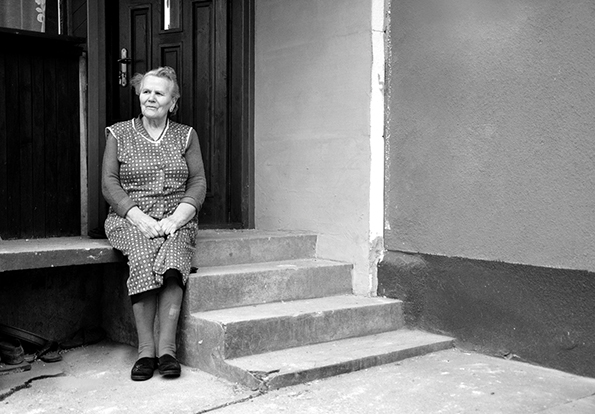
Emilia Wisła
„Czas umarł na czas. Ja umarło na ja. Nie ma ja. Się jest. Się jest się. Się jest duch. Się jest nikt”.
(Edward Stachura, Się1)
1 E. Stachura, Się, w: idem, Poezja i proza. Opowiadania, red. H. Bereza, Warszawa 1982, s. 421.
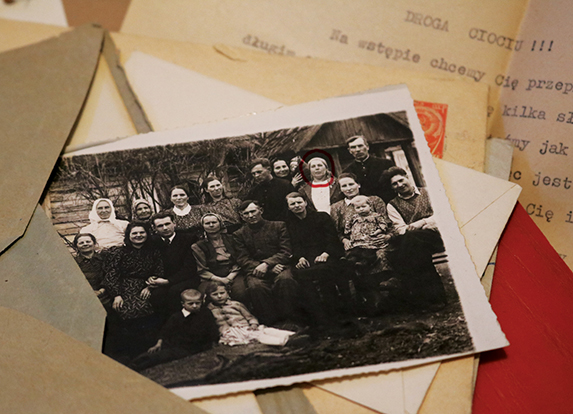
Alicja Kamińska
Jedna z sióstr mojego pradziadka została przesiedlona na wschód i tam już pozostała. Mój dziadek chyba nigdy nie poznał osobiście swojej ciotki, niemniej przez lata pisywali do siebie listy. Kiedyś ciocia przesłała mu zdjęcie całej rodziny, która przebywała na obczyźnie.
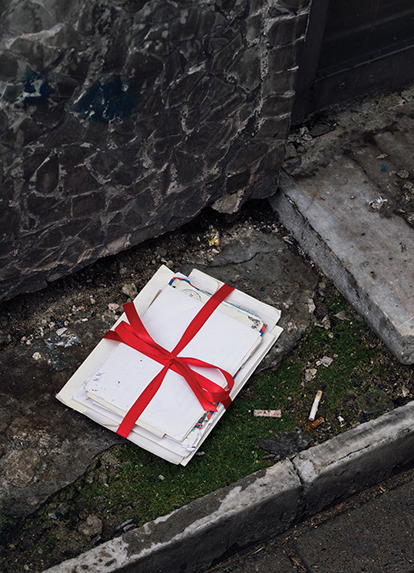
Marta Chudek
Współcześnie listy nie spełniają już tak ważnej funkcji jak choćby dwadzieścia lat temu. Niemniej jednak pozostają dokumentami, które mogą przybliżyć poglądy i osobowość ich nadawcy. Są więc pewnego rodzaju biografią i pamiątką umożliwiającą nam poznanie ich autora. Nieistotne jest, czy to członek naszej rodziny, czy ulubiony artysta, którego dzieła podziwiamy. Każdy list opowiada swoją własną historię.
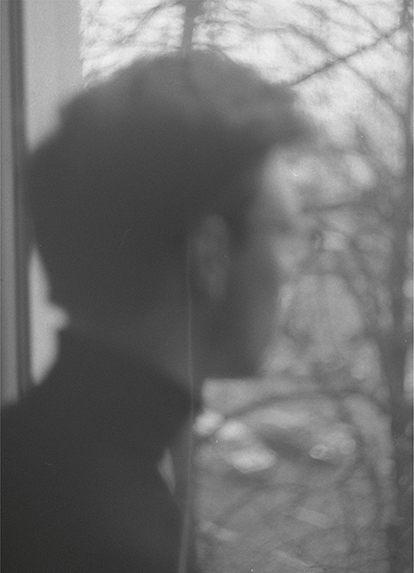
Łukasz Horbów
„Świat listu został roztrzaskany przez telefon, teraz atakuje go skrzyżowanie telefonu i listu, niechlujny i szybki mutant w postaci e-maila. Ale w naszym narastającym luksusowym chaosie nieustannie odnajdują się i spotykają ludzie, którzy odkrywają, że w intymności kontaktu na odległość nic nie zastąpi listu, choćby był pisany na komputerze”.
(Tomasz Jastrun, Wielkie jedzenie listów2)
2 T. Jastrun, Wielkie jedzenie listów, „Polityka” z 26 września 1998 r.
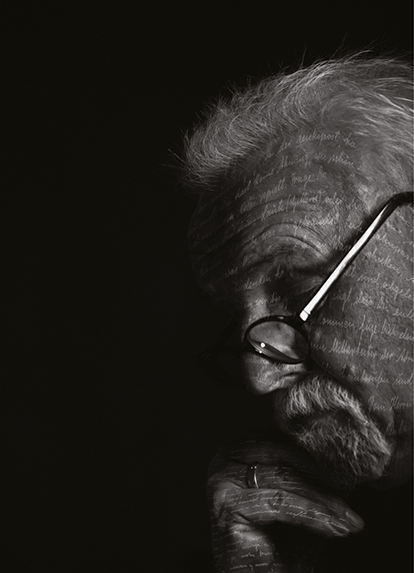
Olga Bronikowska
List umożliwia ukazanie siebie w sposób autentyczny, ale tylko wtedy, gdy poświęci się na niego czas, zagłębiając się w zakamarki własnych uczuć.
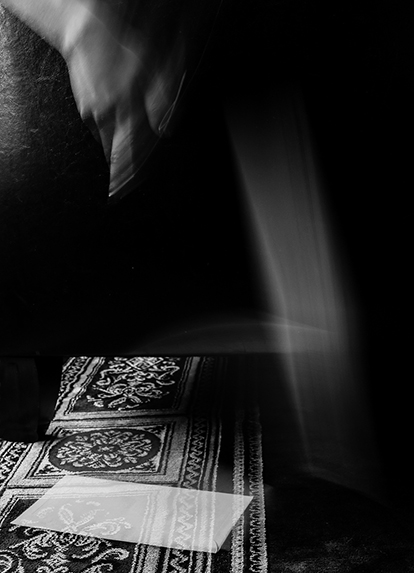

Julia Masłosz
„To tylko papier. Co ma zostać w sercu, zostaje, nawet jak się spali list. Można przechować, a co nie ma zostać, i tak nie zostanie”.
(Haruki Murakami, Norwegian Wood3)
3 H. Murakami, Norwegian Wood, tłum. D. Marczewska i A. Zielińska-Elliott, Warszawa 2006, s. 468.
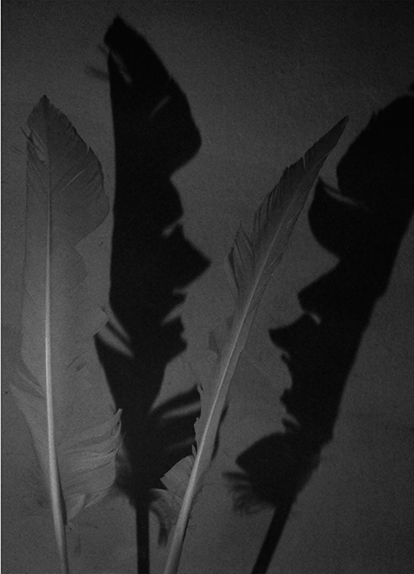
Marta Bogdańska
Bez komentarza.

Maja Hylewicz
„Lepiej piszę, niż mówię”.
(Christiane Felscherinow, Sonja Vukovic, Christiane F. Życie mimo wszystko4)
4 Ch. Felscherinow, S. Vukovic, Christiane F. Życie mimo wszystko, tłum. J. Giszczak, Warszawa 2014.
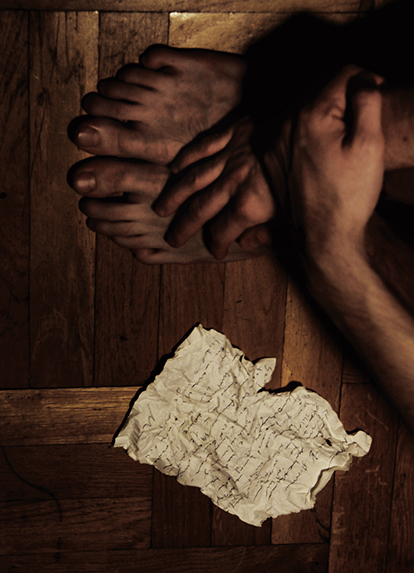
Luiza Grądziel
List bywa czymś niezwykłym. Napisany ręcznie nie jest do podrobienia, nie da się cofnąć napisanych słów lub z łatwością ich wyrzucić. Działają często dużo mocniej, niż słowa wypowiedziane. Na kawałku papieru wyrażamy najważniejsze uczucia, których wymówienie nie przeszłoby nam przez gardło. List daje możliwość przekazania całego siebie, dlatego jest taki wyjątkowy.

Paulina Niedzielska
Kochać Cię w obliczu wyzwań dzisiejszego świata, to jak usiąść i przysypiać w fotelu, w pokoju pozbawionym światła. Gdzie nikt i nic nie zakłóci kojącej ciszy, gdzie nic innego poza nami się nie liczy. Kochać to 55 słów idących w lata. I kiedy ktoś zapyta, czy mam Cię dość, to odrzeknę, że brak Ciebie to dopiero byłaby strata.
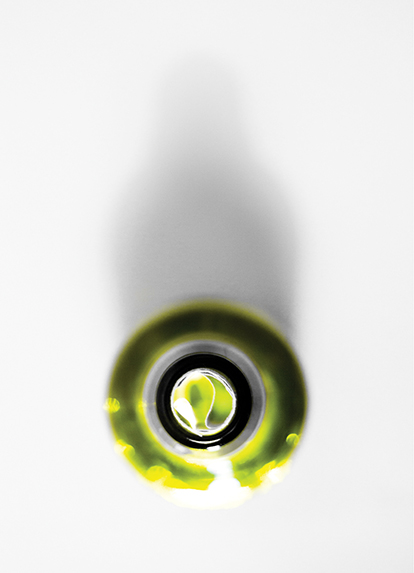
Kacper Krawczyk
„Jednym z uroków czytania starych listów jest to, że nie wymagają odpowiedzi”.
(Przypisywane George’owi Byronowi)
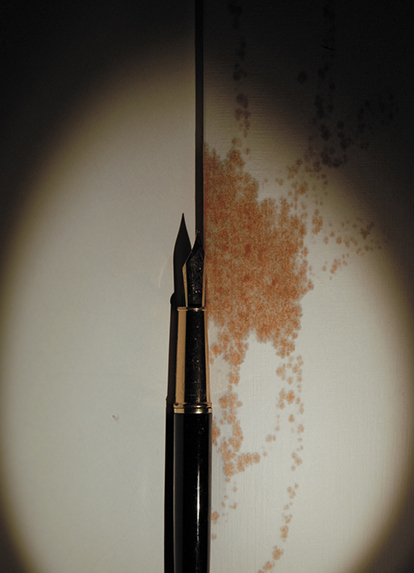
Zuzanna Będkowska
Bez komentarza.
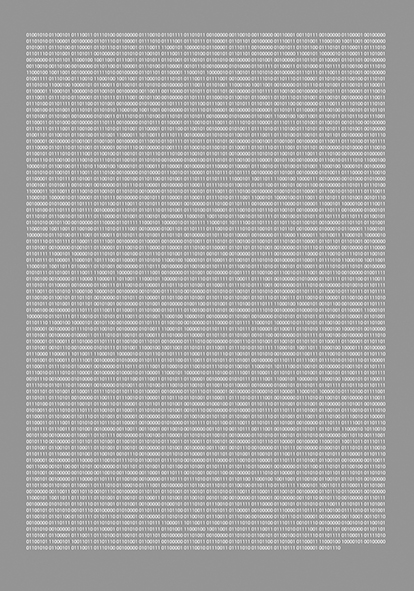
Stanisław Klucznik
List napisany w systemie binarnym – pozycyjnym systemie liczbowym, w którym podstawą jest liczba „2”. Do zapisu liczb potrzebne są tylko dwie cyfry: „0” i „1”, w kodzie powszechnie używanym w elektronice cyfrowej, gdzie minimalizacja liczby stanów (do dwóch) pozwala na prostą implementację sprzętową (odpowiadającą zazwyczaj stanom „wyłączony” i „włączony”) oraz na zminimalizowanie przekłamań danych. Język ten doskonale przyjął się w informatyce i kodowaniu. Jak w każdym pozycyjnym systemie liczbowym, liczby zapisuje się tu jako ciągi cyfr, z których każda jest mnożną kolejnej potęgi podstawy systemu.
Przedstawiona praca jest formą „kapsuły czasu” dla kolejnych pokoleń rozwijającej się ery technologicznej – zawiera zakodowaną informację z moimi danymi, a także aktualnymi wiadomościami związanymi z naszym krajem: począwszy od ilości ludności, rządzącej władzy czy stolicy państwa.
